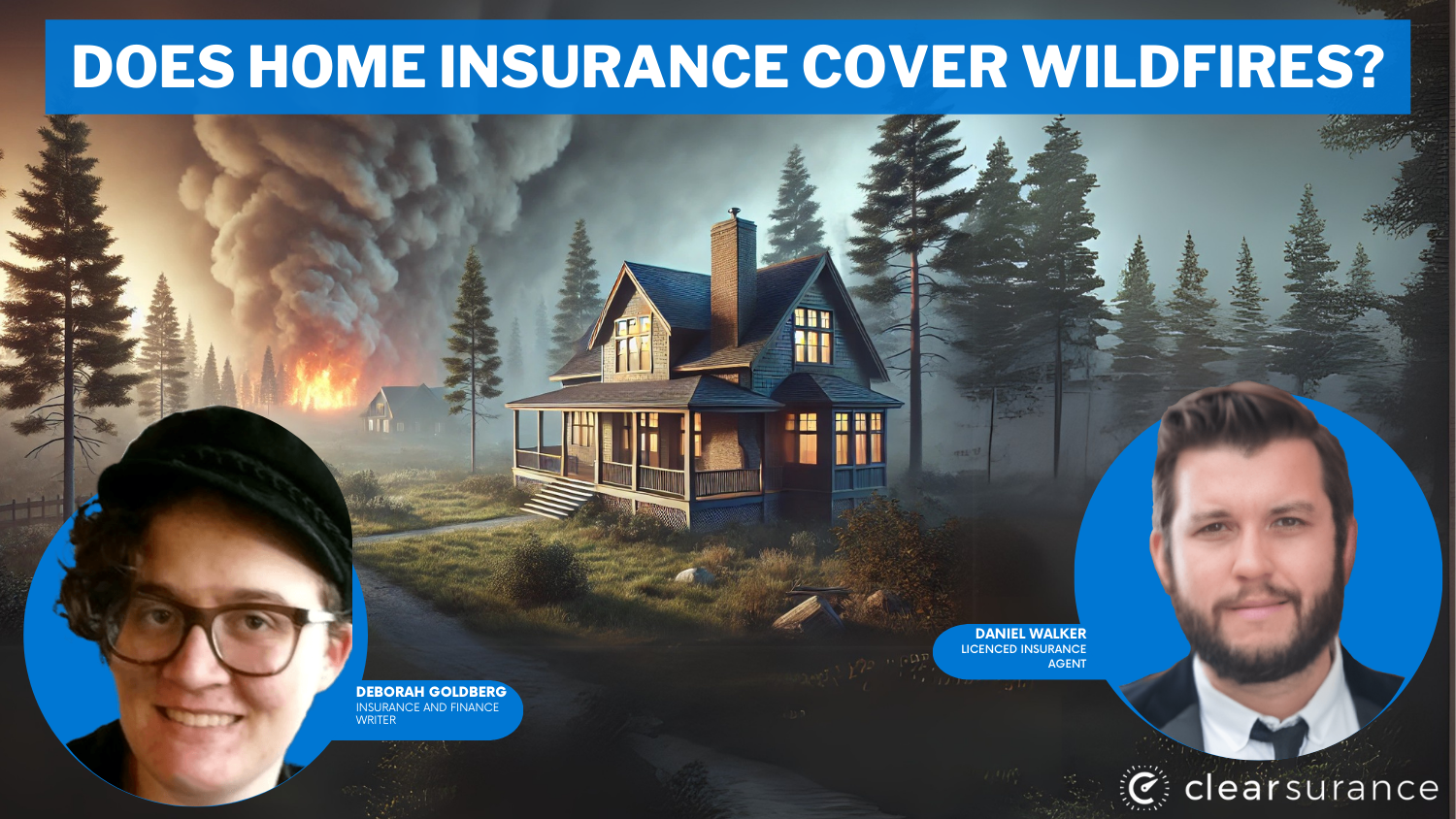
Wondering does home insurance cover wildfires? Home insurance will cover wildfires unless wildfires are listed as an excluded peril on your policy.

Wildfires are commonly exluded in high-risk states like California, so it is important to check your policy. While safety is of the utmost importance when it comes to wildfires, it's also critical to ensure you're properly covered in the event your home and belongings are damaged by a wildfire.
Looking for home coverage from the best and cheapest homeowners insurance companies? Find wildfire insurance coverage for your home today by using our free quote tool.
What You Should Know
- Most losses from wildfire will be covered under a standard home policy
- It may be hard to find home coverage in high-risk wildfire states
- Double-check that wildfire is not an excluded peril on your home policy
Home Insurance That Covers Wildfire Damages and Losses
Are wildfires included in homeowners insurance? Your home will be covered for wildfires if it listed as an included peril. Below are some common types of home insurance that will help pay for wildfire losses and repairs.
| Coverage | What It Covers |
|---|---|
| Additional Living Expenses (ALE) | Temporary living arrangements if your home is uninhabitable due to wildfire |
| Dwelling Coverage | Repair or replacement value of your home |
| Liability Coverage | Legal and medical expenses for injuries on your property during a wildfire |
| Other Structures | Structures on your property not attached to the house, like sheds and fences |
| Personal Property | Belongings inside the home such as furniture, electronics, and clothing |
If you do experience a loss due to a wildfire, your dwelling fire insurance coverage will most likely cover the cost of repairing your damaged home or rebuilding it, up to the limits outlined in your policy.
Personal property will also cover the cost of your belongings inside your house when making a fire damage claim. However, you may want to make some adjustments to your home insurance coverage for the guarantee that you will be properly reimbursed.
Below, you can see the average monthly cost of home insurance at popular companies to get an idea of how much basic coverage costs.
| Insurance Company | $200K Policy | $300K Policy | $500K Policy | $1M Policy |
|---|---|---|---|---|
| $120 | $155 | $230 | $420 | |
| $125 | $160 | $235 | $425 | |
 |
$115 | $150 | $225 | $410 |
 |
$105 | $140 | $215 | $395 |
| $110 | $145 | $220 | $400 |
If you live in an area or state that is at a higher risk for wildfires, it’s important to make sure that your home inventory is kept up to date. (Read More: Avoid Losing on a Home Insurance Claim — Prepare a Home Inventory)
High-risk areas like LA recently experienced an estimated $250B in losses according to AccuWeather, so having a home inventory will help protect you against financial losses. You should also make sure that home inventory is stored in a safe location .
Your homeowners insurance policy might also help pay for temporary housing or living expenses if you need to live elsewhere while your home is being repaired or rebuilt. Check your policy or talk to your agent to learn about any possible coverage limits and exclusions.
Losing a home to a wildfire can be a frightening and emotional experience. Knowing what your homeowners insurance policy covers and being prepared with a home inventory can help with your peace of mind, particularly if you live in an area that is at a higher risk.
Ensuring That Wildfires are a Covered Peril
Some insurers might not include wildfires as a “covered peril” in areas that are prone to repeated wildfires. It is important to check the homeowners declarations page of your insurance policy carefully to see if wildfire is a covered peril.
If you live in a state where wildfires are more common, you may still be able to get fire insurance, but your homeowners premium will most likely reflect that increased risk.
Below is a table showing the states with the most homes at risk of being damaged by a wildfire, based on data from the Insurance Information Institute. In the top 10 states combined, there's more than 4 million homes at risk.
| Rank | State | At-Risk Properties |
|---|---|---|
| #1 | California | 2,048,800 |
| #2 | Texas | 715,300 |
| #3 | Colorado | 366,200 |
| #4 | Arizona | 234,600 |
| #5 | Idaho | 171,200 |
| #6 | Washington | 154,900 |
| #7 | Oklahoma | 152,900 |
| #8 | Oregon | 148,800 |
| #9 | Utah | 133,100 |
| #10 | Montana | 133,000 |
In California alone, there are more than 2 million homes at high or extreme risk of wildfires, the highest amount in the U.S. While California is notorious for wildfires, especially in recent years, there are many other areas in the United States also at high risk for wildfires, such as Texas, Colorado, and Idaho.
If you haven't shopped for homeowners insurance recently or are looking for a new company that covers high-risk wildfire areas, see which insurers other homeowners have had the best experiences with by checking out the top-ranked homeowners insurance companies.
Home Insurance And Wildfire Statistics
Although some wildfires are caused by nature, such as lightning strikes, the National Park Service estimates that 90% of the wildfires in the United States are caused by humans.

These wildfires have a huge economic cost on insurance companies, which is why some companies refuse to cover homes in high-risk wildfire states.
In 2018, there were 58,083 wildfires in the United States, resulting in losses of $3.1 billion. The fires in 2018 resulted in a total of 8,767,492 homes being burned. The November 2018 wildfires in California (the Camp Fire in Paradise and Butte County and the Woolsey and Hill Fires in Los Angeles and Ventura Counties) resulted in more than $11 billion in insured losses.
Read More: Top 5 Lessons Learned from Consumer Reviews After a Natural Disaster
These wildfire losses have increased over the years, with $5.5 billion lost in properties in 2024 alone.

While wildfires generally occur in forested areas or grasslands, and homeowners who live in the mountains or foothills are particularly at risk. Drought conditions and high temperatures contribute significantly to increased risk of wildfires.
Shopping for Home Insurance That Covers Wildfires
Googling does insurance cover wildfires on Reddit? Because policies vary, the only way to see if your home insurance covers wildfires is to check your policy exclusions or call your insurance company.
While most insurance companies will cover wildfires, some will exclude wildfires in a high-risk state (Read More: A Practical Guide for Understanding Homeowners Insurance).
If you need to find home insurance in high-fire-risk areas, use our free tool to get quotes from home insurance companies in your area.
Frequently Asked Questions
Does homeowners insurance cover fire and earthquakes?
Wondering does homeowners insurance cover natural disasters? Homeowners insurance will usually cover natural disasters like fire and earthquakes as long as they are not listed as an excluded event on your policy.
Does homeowners insurance cover wildfires in California?
Wondering does insurance cover wildfires in California? It can be difficult to get wildfire insurance in California. You may have to purchase wildfire insurance coverage separately and pay extremely high rates.
Need to know how to get home insurance after a fire? If you were dropped by your CA provider after a fire, read our article on what to do if your California home insurance is canceled.
Is there a deductible for wildfires?
Yes, you will have to pay your insurance deductible even in the case of a wildfire.
Does renters insurance cover wildfires?
Yes, renters insurance will cover wildfires unless it is listed as an excluded peril on your dwelling fire policy.
What disaster is not covered by insurance?
What disasters may not be covered by insurance depends on your location and insurance company. For example, if you live in an area with frequent flooding, flood damage may not be covered on a regular insurance policy unless you purchase additional flooding insurance (Learn More: Does homeowners insurance cover flooded basements?).
Does property insurance cover wildfires?
Yes, in most cases, property insurance will cover wildfire damages and losses.
What is the 80% rule regarding fire insurance?
The 80% rule means that insurance companies will often require customers to purchase a homeowners insurance wildfire coverage policy that covers at least 80% of the home's replacement value.
Are accidental house fires covered by insurance?
Yes, accidental house fires are usually covered by home insurance. If you want to learn how to lower fire risks, read our guide on the best practices to prevent a fire at your home.
Can you be denied fire insurance?
Yes, you may be denied fire insurance in high-risk areas. In these cases, contact your state department of insurance for assistance with getting homeowners insurance in wildfire-prone areas.
How does FEMA work with homeowners insurance?
The Federal Emergency Management Agency may help cover some costs not covered by your insurance company, such as temporary housing after a natural disaster.
Does renters insurance cover wildfire damage?
Yes, most renters insurance policies will cover damages for wildfires unless it is listed as an exclusion in a high-risk area (Read More: Top 5 Things You Should Know About Your Renters Insurance).
What does homeowners insurance not cover?
Homeowners insurance won't cover deliberate arson, damages from wear and tear, and other preventable incidents.
How much does wildfire insurance cost?
Wondering how much is fire insurance a month? Rates will vary greatly depending on what state you live in, your home's value, and more. Get quotes for fire home insurance today by entering your ZIP in our free quote finder.
Who should you call first when needing to file an insurance claim?
When filing a wildfire insurance claim, call your insurance company first to get the claim process started and learn what evidence you need to collect for the claim. After filing a claim, you may see an increase in your home insurance rates (Learn More: Why did my car and homeowners insurance rates increase?).
What does fire insurance not cover?
Fire insurance typically does not cover fire from events like war or arson.
Why would home insurance not cover a fire?
Companies may exclude wildfires from home insurance policies in high-risk areas like California. Homeowners insurance also won't cover fires set intentionally by the homeowner, as this is insurance fraud.
The content on this site is offered only as a public service to the web community and does not constitute solicitation or provision of legal advice. This site should not be used as a substitute for obtaining legal advice from an insurance company or an attorney licensed or authorized to practice in your jurisdiction. You should always consult a suitably qualified attorney regarding any specific legal problem or matter. The comments and opinions expressed on this site are of the individual author and may not reflect the opinions of the insurance company or any individual attorney.









